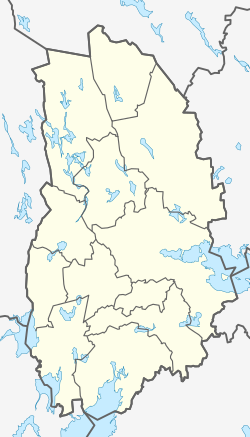Loka Brunn
Loka Brunn | |
|---|---|
Clockwise from top: aerial view of Loka Brunn; Loka garden landscape; the Loka Brunn Church. | |
| Coordinates: 59°36′24″N 14°28′50″E / 59.6067°N 14.4806°E | |
| Country | Sweden |
| County | Örebro County |
| Municipality | Hällefors Municipality |
| Time zone | UTC+1 (CET) |
| • Summer (DST) | UTC+2 (CEST) |
Loka Brunn is a spa town located in Hällefors Municipality in Örebro County, Sweden, south of Grythyttan, and north of Karlskoga, at an isthmus-strip between the southern shore of Lake Norra Loken and the northern shore of Lake Södra Loken.[1][2]
Established as spa town 1720, and granted rights in 1759, Loka Brunn is cited as one of the oldest spa towns in Sweden, along with Medevi and Ramlösa.[3] Since the 17th century,[4] Loka Brunn has been attracting prominent individuals from the aristocrat and bourgeoisie social classes as a meeting place, and according to tradition, the water at Loka Brunn is considered to have health benefits.[5]
History[edit]
Early history[edit]
Established during the Middle Ages, Loka Brunn, served as a resting site for pilgrims according to tradition.[4]
18th century[edit]

Granted mineral rights in 1720, by Conrad Ribbing, governor of Örebro County, in the historical province Västmanland, near the border of Värmland, surrounded by conifer forests,[6] and described by Carl Linnaeus in 1746.
Established as a meeting spot for 18th-century Swedish politicians, the Caps party historically preferred Loka Brunn over Medevi, which instead was favored by the rival Hats.[7]
Loka Brunn has been a site for recovery and treatments since its inception. Notable individuals such as Gustav III,[8][9] Carl Linnaeus, and Bridget of Sweden have all stayed there.[10]
19th century[edit]
Additionally, during the 19th century, individuals suffering from rheumatic disorders sought treatment at Loka Brunn. The site had a pharmacy, a practicing physician and a garden for medicinal plants used in treatment of patients. In addition, a church was inaugurated in 1824.[2]
Refugee camp[edit]
Loka Brunn has been used as a refugee camp on several occasions. After the displacement of individuals during World War II, Danish and Norwegian groups were relocated and housed at Loka Brunn.[11] Later, during the Hungarian Revolution of 1956, a group of Hungarians were also relocated to Loka Brunn where a refugee camp was established.[12]
Today[edit]
In 2007, the Spendrup family acquired Loka Brunn.[13][14] Its workers mainly come from towns nearby, including Karlskoga and Hällefors.[15] In addition, Loka Brunn also hosts a spa town museum.[2]
The Loka Brunn site consists of 54 houses in total.[4] The site offers various amenities and facilities, such as spas, accommodations, and conference rooms.
See also[edit]
References[edit]
- ^ "Loka Brunn - Bergslagen.se". www.bergslagen.se (in Swedish). Retrieved 7 November 2022.
- ^ a b c "Loka brunn". www.lansstyrelsen.se (in Swedish). Retrieved 28 March 2023.
- ^ Jönsson, Håkan; Tellström, Richard (2018). Från krog till krog : Svenskt uteätande under 700 år (in Swedish). Natur & Kultur. ISBN 978-91-27-14592-4.
- ^ a b c "Vår historia" [Our history]. Loka Brunn (in Swedish). Retrieved 7 November 2022.
- ^ Bolin, Gunnar (2019). Hovjuvelerarens barn (in Swedish). Albert Bonniers Förlag. ISBN 978-91-0-017543-6.
- ^ Vilo- och kurorter i Sverige (in Swedish). 1925. p. 79 – via Project Runeberg.
- ^ Marklund, Andreas; Larsson, Olle (2018). Svensk historia (in Swedish). ISBN 978-91-7545-742-0.
- ^ Niklas August, Tengberg (1871). Konung Gustaf III:s första regeringstid till och med 1772 års statshvälfning. Fragment af Gustaf III:s historia (in Swedish). p. 122 – via Project Runeberg.
- ^ "Loka brunn". www.lansstyrelsen.se (in Swedish). Retrieved 7 November 2022.
- ^ Mårtenson, Jan (2019). Dödligt hot (in Swedish). Wahlström & Widstrand. ISBN 978-91-46-23578-1.
- ^ Berglund, Tobias; Sennerteg, Niclas (2010). Svenska koncentrationsläger i Tredje rikets skugga (in Swedish). Natur & Kultur. ISBN 978-91-27-12791-3.
- ^ "Från revolt till kurort". Dagens Arena (in Swedish). Retrieved 28 March 2023.
- ^ "Loka Brunn | Svenska Spahotell". www.svenskaspahotell.se (in Swedish). Retrieved 7 November 2022.
- ^ Lomberg, Sara (15 November 2007). "Spendrups köper Loka Brunn". Svenska Dagbladet (in Swedish). ISSN 1101-2412. Retrieved 7 November 2022.
- ^ Riksdagens protokoll (in Swedish). Kungl. Boktr. 1988.
Further reading[edit]
- Frih, Anna-Karin (2003). ”"Sjuk nästan jemt-": klorotiska flickor och kvinnor vid Loka och Porla brunn ca 1880-1910”. Kvinnor i Örebro län (2003): sid. 111-126 : ill.. Libris 9649863
- Mansén, Elisabeth (2001). Ett paradis på jorden: om den svenska kurortskulturen 1680-1880. Stockholm: Atlantis. ISBN 91-7486-573-0.
- Medlemstidning. Grythyttan: Lokasällskapet.
- Bergius, Peter Jonas (1764). Tal, om kalla bad i gemen, och Loka badningar i synnerhet, hållet för kongl. vetenskaps academien, vid præsidii nedläggande, den 2. november 1763, af Peter Jonas Bergius ... På kongl. vetenskaps academiens befallning. Stockholm, tryckt: hos direct. Lars Salvius 1764. Stockholm.
- Loka: en brunnssommar. Örebro: Morgonstjärnan. 1984. ISBN 91-86204-12-2.
- Kungl. gyttjebad- och brunnsanstalten Loka 1928. Loka.
- Loka: offerkällan som blev "kungens brunn" och en modern kurort. [Grythyttan]: [Grythyttans gästgivaregårds förl.]
- Loka brunn. Grythyttan: Grythyttans antikvariat.
- Sommarbrev från Loka. Norrköping: Norrköpings Tidn. 1948.
- Bevarandeprogram för Loka brunn, Hällefors kommun, Örebro län. Örebro: Länsmuseet.
- Stiftelsen Kungl. Gyttjebad- och Brunnsanstalten Loka (in Swedish). Loka Brunn. 1947.
- Waldén, Bertil. Loka: en kunglig hälsobrunns krönika. Stockholm: Nordisk rotogravyr.
- Otterling, Ingemar (1970). Loka brunn 250 år (in Swedish).
External links[edit]
- Lokabrunn.se – homepage (in Swedish)





